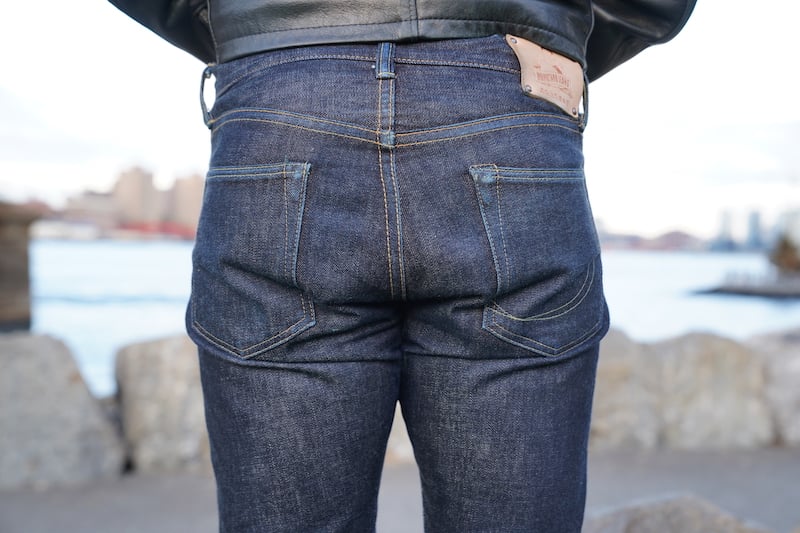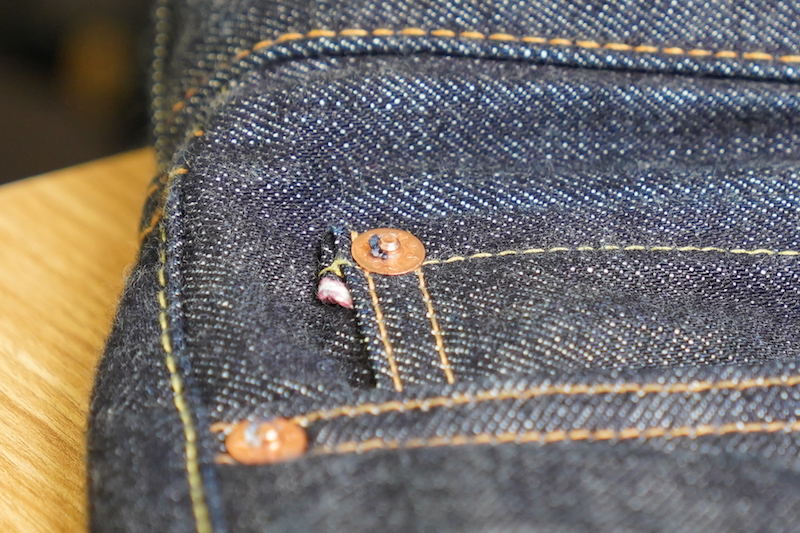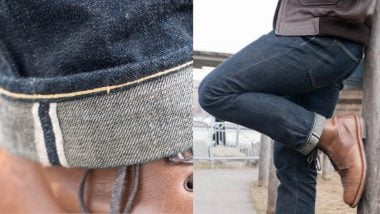Review: Momotaro’s Glossy, Hairy, Hand Made Japanese Jeans
“Made by hand, without compromise” is the slogan of the Kojima-based denim company Momotaro.
Kojima is considered by many as the birthplace of Japanese denim — it’s home to the famous “Jeans Street” that houses many sought after storefronts of Japanese denim institutions. Momotaro is right there among them.
The company has a big emphasis on hand making and hand stitching jeans, and the company’s name means “Peach Boy.” Why? That’s the name of a kind of folk hero in Okayama, a boy born out of a giant peach that the gods sent to a couple who couldn’t conceive. When he got older he fought demons and ogres and such, and that’s why the jeans are absolutely covered in peach iconography, from the sheepskin waist patch to the inside of the yolk to the buttons and copper rivets. Don’t worry, there are plenty of close ups throughout this review.
So let’s get started on my pair: the G015-MZ 14.7 ounce deep colored indigo narrow tapered zipper fly jean.
Momotaro Denim
- 14.7oz
- Zimbabwe cotton
- Relatively high gloss
- Slow to fade
- Very visible white weft
The jeans I picked up are 14.7 ounces, which to most people means it’s midweight, though these are actually some of the most lightweight Japanese jeans I own. (Most Levi’s are between 10.5 and 12.5 ounces, jeans are usually thought of as heavyweight once they’re 17 ounces or so, and there are a few brands out there that make denim over 20 ounces.)
The cotton begins its journey in Zimbabwe. Momotaro is very proud of this and uses phrases like
grown through the grace of Africa’s greatest natural environment
in their marketing.

The brand’s old fashioned, handcrafted ethos starts right at the beginning: the long staple cotton is hand cropped, which helps them to keep out plant matter and impurities and to minimize damage to the thread. Zimbabwe cotton is known for being very white, very flexible, and easy to dye. It’s actually most often used in European dress shirts, but it makes pretty solid jeans as well.

Like a lot of Japanese jeans, it’s woven by vintage shuttle looms. That kind of old fashioned production process often produces very irregular, slubby denim like Studio D’Artisan or Pure Blue Japan, but that’s not the case for Momotaro: it’s pretty uniform and slick, even a little glossy, due to the Zimbabwe cotton’s natural sheen. If you look closely, you can see plenty of fine “hairs” protruding from the jeans and they’re not as slick and smooth as something like Iron Heart. It’s sort of right in the middle: not very slubby, not very slick.

The crotch fading a little after a few weeks of wear. Note the pink inseam.
Momotaro says these jeans have the “world’s most deep color,” and while it is synthetic indigo, it’s still a nice deep blue. Just note that the white weft is quite visible here, and they deliberately dye it so that the center of the thread isn’t dyed and stays white, so that when it fades it fades the way people want it to.
[Learn more: Why Zimbabwe Cotton Is So Popular]

A cross section of the dyed cotton, showing the white center that helps to produce desirable fades. This image is taken from the unbelievably cool documentary Momotaro put on YouTube that you should definitely watch.
Momotaro Jeans Details
- Zipper fly
- Adorned with peach and demon motifs
- 20 types of threads used
- Pink selvedge ID
I was really happy to finally get some Japanese jeans with a zipper fly, which is very unusual, but the G015-MZ has it. Very unusual, very easy to go to the bathroom, and for those who lament the fact that this means fewer buttons, well, OK, you’re right. But you do still get some very nice, engraved copper buttons and rivets, and each and every one of them is adorned with a peach motif, which I just love.

A peach on the fly and peaches on the inside of the yoke.

There’s also a boy coming out of a peach on the sheepskin waist patch and what looks like a grown up Momotaro squaring off against a demon on the inside of the flannel pockets. (Fun fact: the Japanese word for demon or ogre is Oni, the name of another Okayama-based denim company. Which I reviewed!)
Then we need to talk about the stitching. The company says they use about 20 types of threads in their jeans, like cotton threads and core yarn threads. Most of the stitching is a dark gold color but the color of the threads vary to lighter yellow, on the belt loops and the snazzy swoop on the back pocket…

… to what might be the best known aspect of Momotaro jeans, the bright pink selvedge ID. The pink stitching runs all the way up the inside of the legs and I absolutely love it. I imagine, and I have zero research backing this up, that some guys out there might not love the idea of pink on their jeans. But I think it looks great, and it makes me pair the jeans with more grey, blue, black, and white-type colors than earthy browns and greens.
[Related: 7 reasons Japanese denim is worth the cost]

Momotaro Denim Care
- Wash separately from other clothes
- Wash inside out
- Famously slow to fade
The label says wash separately, wash it inside out, and not to tumble dry or dry clean. So pretty standard instructions; like all quality jeans, the indigo will seep into the water and ruin all your clothes if you don’t separate them.
A lot of people out there will only wash their Momotaros every 60 wears or so (if that), it’s a very individual question as to how often you should wash selvedge jeans. But even though synthetic indigo is meant to fade faster than natural indigo, Momotaros are famously pretty slow to fade.
I’ve got about 50 or so wears in these without washing and while it’s lightening up a little around the back pockets, most of my jeans are getting some nice electric blue lines around the waist by now. Not the Momotaros; most people say you need a good year before you start seeing the natural vertical fades that may eventually become something like this this 3-year-old pair from Reddit user Saikyo.
[Related: The 4 biggest misconceptions about raw denim]

Sometimes, the pink really pops
Momotaro G015-MZ Fit & Sizing
- Okayama Denim calls this a “lifter’s cut”
- Bigger thighs, larger glutes
- Order a size up from your normal waist
If you’ve read my other reviews, you know what I’m about to say: I have pretty big thighs and a tall butt so I always get jeans with a high rise and a relaxed tapered sort of fit. Okayama Denim calls this G015-MZ “a lifter’s cut” for “bigger thighs and larger glutes,” though the cuff is very narrow, to the point that I usually have to sit down and tug when I’m trying to get them off.
All my American pants are size 32, I ordered these in 32, and I’ll be honest, I should have gone a size up. When they arrived, I couldn’t put them on.
Should I have ordered a bigger size? Yes.
Should I have returned them? Yes.
Was I too lazy to do so, and too cheap to pay the shipping fees to Japan? Yes.
Denimio does not do free exchanges, so I just muscled these on and lunged around New York trying to stretch them out and now, they’re probably my best fitting slim jeans. But they are pretty darn slim.
It still wrinkles a little on the thighs when I bend my knees, which I know means they’re not the ideal fit, and this doesn’t have a very high rise either. But after breaking them in, these have found up a pretty good, clean, slim jean. The fit is lean, though, so I wear them with more modern outfits and slimmer fitting tops.
[Compare with my review of Naked & Famous Left Hand Twill]

Note they still wrinkle just a little on the thighs when I’m sitting.
Momotaro Jeans Cost
I got these on Denimio for $232, on Momotaro’s site they’re $300, but on Okayama Denim they’re $210. So you should get them on Okayama Denim if they’re in stock.
$210 is a pretty great price for a pair of Japanese jeans, which are usually over $300. It’s not especially thick denim, though, so that would contribute to the cost reduction.
[Related: The best selvedge jeans that aren’t raw]
Momotaro Jeans Pros & Cons
Pros
- Under $250
- Handmade
- Very cool peach details
- Sturdy, secure stitching
- 14.7oz can be warn in warmer weather
Cons
- Synthetic indigo
- Slow to fade
- Very clean, not fuzzy/slubby
- Pink stitching might turn off some people

These jeans are well priced and the denim has a good balance of cleanness and hairiness — which is to say you can tell they’re not your regular, sleek, run-of-the-mill jeans, but they’re not over the top slubby and neppy. Of course, whether that’s a pro or a con depends on the consumer: some adore ultra hairy jeans, others want jeans that won’t draw as much attention.
They’re famously slow to fade, but you can expect a nice patina on these jeans owing to the fact that the core of the thread isn’t dyed and the white weft shows through even when they’re new. I adore the peach motifs and I’m crazy about the pink stitching: it’s just different enough to be memorable, but it’s sleek enough to blend in in Manhattan. In addition to all that, the stitching is very secure; after months of wear, I’ve experienced precisely zero loose threads.
All in all, it’s a great pair of jeans. Just make sure you’re OK with pink.
Thanks to Dave Stewart at Japanalogue for lending his Japan expertise to this review. Check out his site!










Hey man, another super solid review, just like all the rest!
Dave you’re my hero, thank you for enjoying and commenting!
Great info Most people don’t like bootcut but , if you happen to have own Momotaro bootcut , can someone give me an in-depth review like this with the bootcut , like denim dye real indigo or fake , fit , basically very detailed
Thank you
love momotaro jeans, and love the pink inseam! will look into getting some zimbabwe cotton
I did a whole article on it! https://stridewise.com/zimbabwe-cotton-jeans/